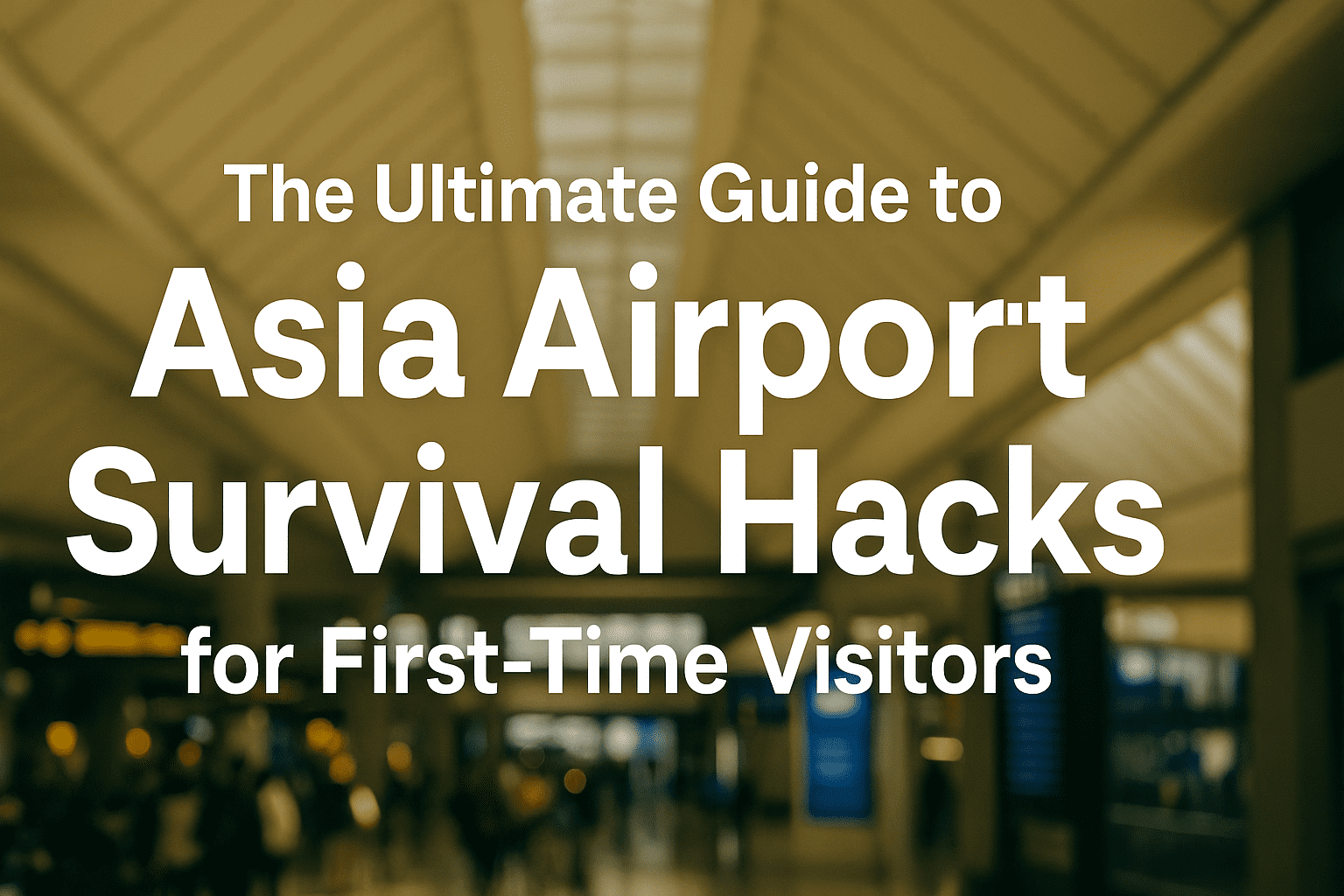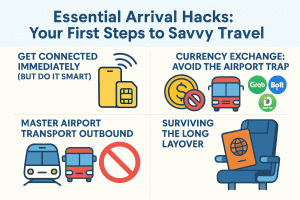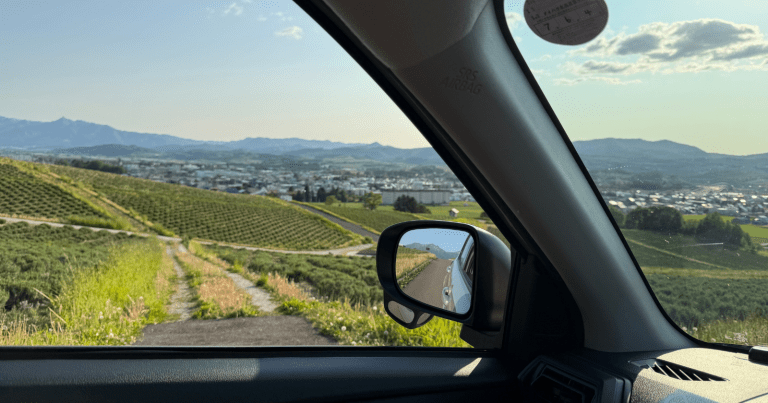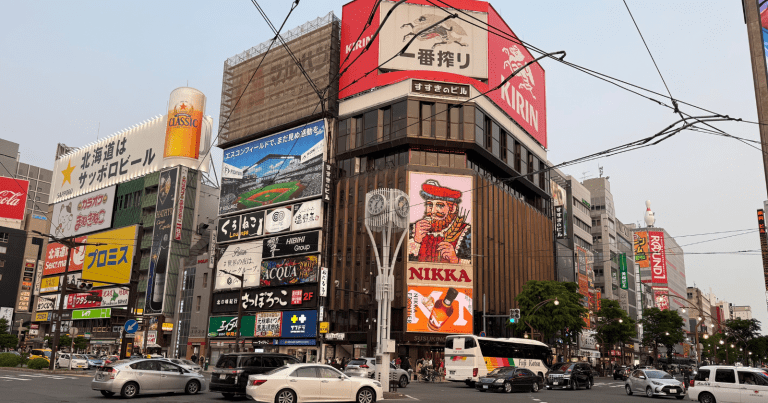
Stepping off the plane into a major Asian airport for the first time can feel like plunging headfirst into a vibrant, yet sometimes overwhelming, new world. The sheer scale, the unfamiliar languages, the energy – it’s all part of the adventure, but it can also spark anxiety, especially when you’re tired after a long flight.
As a seasoned traveler who’s navigated countless terminals across the continent, I know that feeling. The good news? You don’t have to just survive the experience; you can master it. This guide is your secret weapon, packed with the ultimate Asia airport hacks first time visitors need to navigate arrivals, transits, and departures efficiently, affordably, and confidently.
Forget feeling lost or getting caught in tourist traps right off the bat. We’re talking about practical, actionable strategies that empower you to bypass common pitfalls and start your Asian adventure on the right foot. Think less stress, more savvy travel right from the moment you land. Ready to unlock the secrets to smooth airport transits in Asia?
Essential Arrival Hacks: Your First Steps to Savvy Travel
Your experience of Asia begins the moment you arrive at the airport. Being prepared for those crucial first few minutes and hours can make all the difference.
Get Connected IMMEDIATELY (But Do It Smart)
My number one piece of advice for any first-time visitor landing in Asia: secure your mobile connectivity *before* leaving the airport. Why? Because having data and a local number is your lifeline – for navigation, communication, booking transport, and quick searches.
Airport kiosks selling SIM cards are ubiquitous in Asia’s major hubs, but the key is knowing which one to choose and what package you need. Avoid the first vendor you see right outside customs; often, these are slightly more expensive. Look for official telecom provider stores within the terminal. Have your passport ready, as registration is usually required. Consider how much data you’ll need and if you need international calls.
For most independent travelers relying on apps like WhatsApp and mapping tools, a data-heavy package is best. Prices are generally very reasonable compared to Western standards. Setting this up while still in the controlled environment of the airport lobby means you step outside connected and ready to go.
Alternatively, if your phone supports it, research eSIMs before you even leave home. Many providers offer Asia-wide or country-specific eSIMs that you can activate on arrival, saving you the hassle of swapping physical SIMs and potentially offering competitive rates. This is a particularly savvy move for those who want instant connectivity without the queue.
Currency Exchange: Avoid the Airport Trap
You’ll need local currency, but the airport currency exchange booths are notorious for offering poor rates. They rely on the convenience factor and your immediate need for cash. Exchange just enough to cover your immediate airport transport (like a train ticket or initial taxi fare) and perhaps a bottle of water. Plan to exchange larger sums in the city center at official banks or reputable exchange offices, which offer significantly better rates.
Better yet, look for ATMs connected to major international networks (Visa, Mastercard, Plus, Cirrus). Withdrawing cash directly from an ATM using your debit card typically provides a much better exchange rate than physical exchange booths, though be mindful of potential fees from both your home bank and the local ATM operator. Always inform your bank before you travel to avoid your card being blocked.
While the travel itself involves change, the airport can be where that initial friction occurs. Being prepared for the practical steps, like smart money exchange, eases that transition.
Mastering Airport Transport Outbound
Once you’re connected and have a little local cash, your next mission is getting from the airport to your accommodation. This is where many first-timers get flustered or overpay. Research your transport options *before* you land. Most major Asian airports offer several choices:
- Airport Rail Links: Often the fastest and cheapest option, especially in traffic-heavy cities. Look for clear signage directing you to the train station. This is usually my go-to method as a budget-conscious traveler.
- Buses: Generally the cheapest, but can be slower and less direct. Good if you’re not in a hurry and want to save money.
- Taxis: Convenient but prone to scams (fixed high prices, rigged meters). Always use official airport taxi stands. Confirm the use of the meter or agree on a fare *before* getting in. Have your destination address written in the local language or ready to show on your phone’s map app.
- Ride-Sharing Apps (Grab, Bolt, inDrive): These are incredibly popular and reliable in many parts of Southeast Asia and function much like Uber. Download the app before you arrive. They offer transparent pricing and you pay via the app or with cash, eliminating meter issues. Look for
-

designated pick-up points, which are usually well-signed. This is often the best balance of convenience and fair price.
Understanding these options and having a plan (even a backup plan) is crucial. Don’t just grab the first tout who approaches you. They are almost certainly overcharging you.
Advanced Airport Navigation: Layovers, Language, and Logistics
Beyond the initial arrival, Asian airports, especially major hubs, can serve as transit points or places where you might spend significant time during layovers. Knowing how to utilize these spaces effectively is key.
Surviving the Long Layover
Got hours to kill? Asian airports, particularly those frequently ranking among the world’s best like Singapore Changi or Seoul Incheon, are often destinations in themselves. Explore! Many offer free movie theaters, gardens, art installations, quiet zones, showers, and even free city tours for longer layovers. Don’t just sit at your gate. Find a comfortable spot in a quiet zone, look for dedicated sleeping areas or pods (some free, some paid), or consider paying for lounge access even if you’re flying economy.
Airport lounges offer comfortable seating, free Wi-Fi, food, drinks, and sometimes showers – a worthwhile investment for a really long layover, especially overnight. Research the specific airport’s amenities beforehand via their official website.
Bridging the Language Gap
While major airports usually have staff who speak some English, navigating ticket machines, asking for directions, or dealing with unexpected issues might require overcoming a language barrier. Have a translation app like Google Translate or iTranslate downloaded on your phone, preferably with offline language packs for the countries you are visiting.
Being able to type in a phrase or show a translated sentence on your screen can save a lot of frustration and misunderstandings. Don’t be afraid to use gestures and point – most people are willing to help if they understand what you need.
Food & Drink: Avoiding the Peak Price Trap
Airport food is expensive everywhere, but savvy travelers know how to find better value. Step away from the main international food court aimed at tourists. Many large Asian airports have staff canteens or more local food courts tucked away in less obvious spots, often in older terminals or ground transportation areas. These offer significantly cheaper and often more authentic options than the glossy international chains.
For instance, Singapore Changi Airport has an amazing staff canteen that’s accessible to the public and offers delicious local food at a fraction of the price of the main food courts. Always carry a reusable water bottle and look for water fountains instead of buying single-use plastic bottles at inflated prices. Some airports even have hot water dispensers for tea or instant noodles, a great budget hack if you came prepared with your own.
This budget-conscious approach to even airport food echoes the spirit of a true bargain hunter, reminding you that smart choices can be made at every step of the journey, not just when exploring vibrant street food scenes later.
Niche Hacks and Resource Pointers for Smooth Sailing
Beyond the standard procedures, a few specific tips and knowing where to find ongoing information can further enhance your airport experience in Asia.
Handling Delays and Cancellations
Flight disruptions happen. If your flight is delayed or cancelled while you’re at an Asian airport, remain calm and head directly to your airline’s service desk. Be prepared for long queues during major disruptions. Having your booking details easily accessible (screenshot or printed) is crucial. If the delay is significant, inquire about meal vouchers, accommodation, and rebooking options. Know your passenger rights – while they vary by country and airline, many Asian countries have regulations offering compensation or assistance in certain situations. Resources like the International Air Transport Association (IATA) provide general information on passenger rights, though local rules always apply.
Baggage Claim Speed and Strategy
Waiting for luggage can feel like an eternity. To minimize wait time, try to be one of the first off the plane. If you have priority tags (sometimes obtained through frequent flyer status or specific credit cards), your bags should theoretically come out first. But even without them, positioning yourself strategically by the baggage belt and recognizing your bag quickly saves time. If your luggage doesn’t appear, immediately go to the airline’s lost and found desk, usually located in the baggage claim area. Having a photo of your luggage and any luggage tags on your phone is incredibly helpful for filing a report. Attach a distinctive tag or ribbon to your bag to make it easily identifiable on the belt.
I once spent a frustrating hour searching for my bag at Manila airport, only to discover someone with an identical bag had mistakenly taken mine. Since then, I always add a bright, easily recognizable strap or ribbon. It’s a simple trick that saves a surprising amount of hassle and prevents mix-ups, proving that small details matter when exploring places like the Philippines.
“A journey of a thousand miles begins with a single step.”
– Lao Tzu (Often attributed)
That first step often involves navigating the airport. Being equipped with knowledge makes that crucial initial part of your journey smoother and more enjoyable, setting the stage for everything that follows.
Utilizing Airport Resources & Staying Updated
Official airport websites and apps are invaluable resources. They provide real-time flight status, terminal maps, information on transportation options, amenities, and sometimes even details on visa on arrival processes. Bookmark the website for the airports you’ll be using before your trip. For real-time conditions and advice, check traveler forums like the Thorn Tree forum on Lonely Planet or specific country/city subreddits on Reddit. Seasoned travelers often share recent experiences regarding airport procedures, transport availability, or current conditions that official sites might not cover immediately.
Dealing with immigration queues can be lengthy. Ensure you have your visa or eligibility for visa-on-arrival confirmed *before* your trip. Have all necessary documents (passport, visa, onward ticket, accommodation booking) easily accessible, ideally in a dedicated travel document folder or app, to speed up the process. Some airports offer express immigration services for a fee – weigh if the cost is worth the time saved based on queue lengths you observe or research.
Conclusion: Step Out Confidently
Navigating Asian airports doesn’t have to be a daunting challenge. By understanding the key steps – securing smart connectivity, being strategic with currency, knowing your transport options, preparing for potential delays, and utilizing available resources – you transform from a potentially overwhelmed first-timer into a confident, savvy traveler.
Remember to research your specific arrival and departure airports beforehand; while these are general hacks, each airport has its own nuances. Stay calm, be observant, and don’t be afraid to ask uniformed staff for help. With these hacks in your back pocket, you’re ready to move through the airport with ease, ready to dive into the incredible experiences that await you in Asia.
Happy (smarter) travels!







